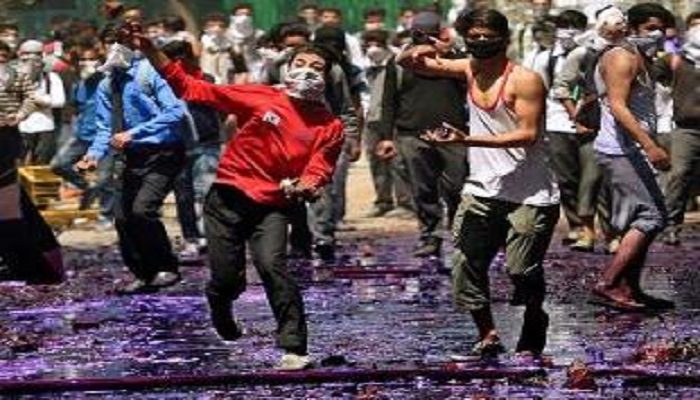The situation has remained grim since the Modi government came to power, as it has treated the Kashmir problem merely as that of law and order and had been trying to tackle the issue by use of force. It has fully swallowed the theory of the NSA Ajit Doval that the protestors should be suppressed to the extent that they do not dare to raise their heads again. The security forces have become more aggressive since the widespread protest against the killing of Burhan Wani who has been projected as a dreaded terrorist though many counter this claim of the administration. A report, for Different Truths.
With the daily worsening situation in the Kashmir Valley, the political parties including the partners of the ruling alliance have unanimously urged the Union government to declare a ceasefire for the month of Ramadan and continue it till the end of Amarnath Yatra. They have cited the example of a similar ceasefire that was observed in 2000 when BJP leader Atal Behari Vajpayee was the prime minister.
The initiative is welcome but not sufficient. It is not that the situation in the Valley, particularly in South Kashmir, has started deteriorating after the death of a tourist youth from Tamil Nadu who was hurt in stone pelting by protestors against the high-handedness of the security forces. The situation has remained grim since the Modi government came to power, as it has treated the Kashmir problem merely as that of law and order and had been trying to tackle the issue by use of force. It has fully swallowed the theory of the NSA Ajit Doval that the protestors should be suppressed to the extent that they do not dare to raise their heads again. The security forces have become more aggressive since the widespread protest against the killing of Burhan Wani who has been projected as a dreaded terrorist though many counter this claim of the administration.
Since then the killings under the garb of “encounters” have become a routine affair. Ordinary people are constantly under attack. People complain about the high-handedness of police and security forces. There have been allegations of raids on houses of innocents, of molestation and even rape of women and abduction. Each action of the government leads to an intensification of resentment and protest actions are getting wider support. The government had regularly tried to pass on the blame on terrorists from across the border.
There are reasons to believe that neighbouring Pakistan has a stake in the Valley and its armed forces have their own strategy of annexing the valley. It does send terrorists and incites violence. But that is not the sole reason for the upsurge in discontent and protests. The problem has the political angle that the present rulers in Delhi are not ready to recognise. Rather they are just working on a strategy that is its opposite and goes against the overall interest of the country.
The people of Jammu and Kashmir rejected the creation of Pakistan on the basis of now much debated two nation theory and decided in favour of accession to India as the leaders of our freedom struggle had favoured the building of India as the Secular Democratic Republic. At that time, apart from the creators of Pakistan, it was the RSS and its allied Hindutva organisations that were opposed to Kashmir’s accession to India on the basis of the two-nation theory propounded by Savarkar, much before Jinnah adopted it.
They dreamt of having a Hindu Rashtra. They also opposed the concept of the maximum of autonomy to the state under Article 370 of the Constitution. They are still of the same opinion and its political wing the Jana Sangh and later the BJP have included a promise to do away with Article 370 and propagated it. Unfortunately, the successive Union governments too helped them by eroding the autonomy of Jammu and Kashmir. It has been the main cause of dissatisfaction and discontent. That remains to be the crux of the Jammu and Kashmir problem.
On the basis of its wrong perception, Narendra Modi government since its formation had been following a basically wrong policy. In place of political leaders taking initiative, the matter has been handed over to people who treat it just as a law and order problem. Most unfortunate part of this process is the utterances and actions of the army chief Bipin Rawat who is echoing the thinking of RSS-BJP.
Apart from the developments within the Valley, the happenings in rest of India are also strengthening alienation and separatism among Kashmiris. The way the Hindutva forces have intensified their fascistic offensive against the basic ethos of our secular democratic Constitution and society is creating new threats to the unity and integrity of the country. Raising a new issue on a daily basis to hasten its plan for caste and communal polarisation of the plural and secular Indian society may garner a few more votes for BJP in 2019, but ultimately it will be wholly against the country’s unity and integrity. Issues like AMU and attack on Jamia Millia Islamia that target the very concept of secularism do affect the minds of Kashmiri people as well.
To resolve the Kashmir tangle, not only political initiative in Jammu and Kashmir is required but also a counter-offensive against those who are bent upon destroying the very secular democratic fabric of our society and Constitution.
Shameem Faizee
©IPA Service
Photo from the Internet






 By
By
 By
By